Indian Spices: Usage, Health Benefits & Cultural Significance
Nestled amidst the vibrant tapestry of cultures and landscapes, India beckons travelers with a tantalizing promise—a journey into the heart of diversity, where every corner reveals a new facet of its rich heritage. At the heart of this mosaic lies India's profound relationship with spices, a heritage that dates back millennia and continues to enchant visitors from around the globe.
India
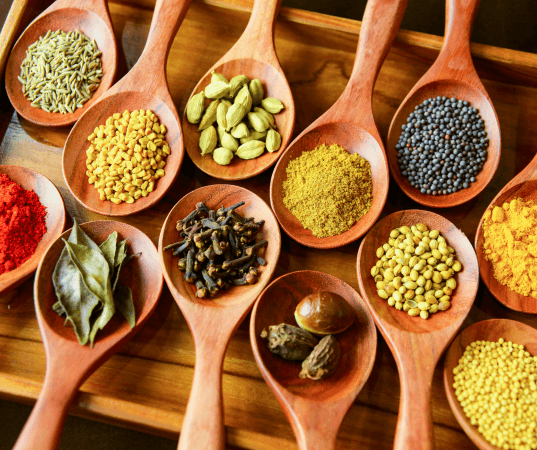
History of Indian Spices
India's association with spices is legendary, with its spice trade once shaping empires and connecting distant lands. “Indians have been used by Indians for thousands of years, around 2000 BC,” stated McCormick Science Institute in their research on the History of Spices. From the fiery red of Kashmiri chili to the earthy warmth of turmeric, each spice tells a tale of history and culinary prowess. The subcontinent boasts a staggering array of over 50 different spices, each contributing uniquely to its aromatic cuisine and holistic wellness practices.
Spices aren't just ingredients here; they're cultural markers, passed down through generations, their origins often steeped in myth and tradition. Take for instance, the story of cardamom, whispered in the mist-clad hills of the Western Ghats. Local legend has it that the fragrant pods were a gift from the gods themselves, cherished for their aroma and medicinal properties. Such anecdotes not only enrich the culinary experience but also deepen the cultural fabric that binds India's diverse communities together.
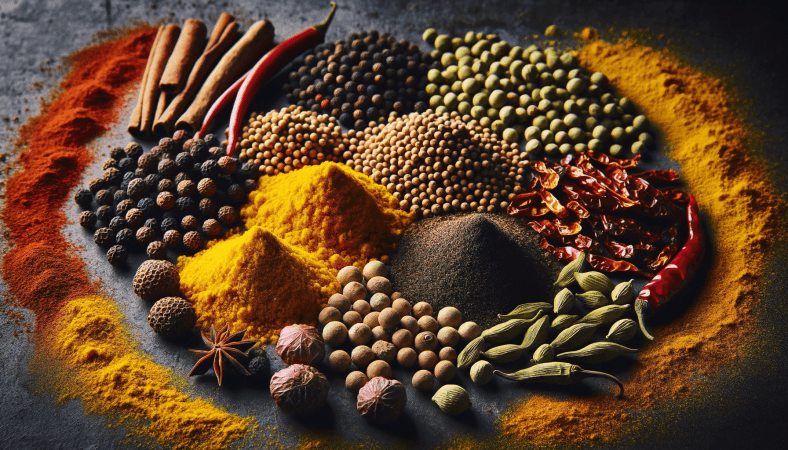
History of Indian Spices - © EFGH Foods
Culinary Uses and Traditional Blends
In Indian kitchens, spices aren't merely sprinkled into dishes; they're meticulously blended to create symphonies of flavor. One of the most iconic blends is garam masala, a fragrant combination of cardamom, cloves, cinnamon, and other spices varying by region. This blend isn't just a seasoning; it's a testament to the culinary artistry honed over centuries.
Across the country, each region boasts its own spice repertoire, reflecting local climates, traditions, and agricultural practices. For instance, the coastal states of Kerala and Goa boast a profusion of spices like black pepper and nutmeg, thanks to their tropical climate and historical trade routes. Meanwhile, in the arid deserts of Rajasthan, spices like cumin and coriander lend their robust flavors to the region's hearty cuisine, designed to withstand the harsh climate.
These traditional blends not only define regional cuisines but also offer a glimpse into the everyday lives of locals. In bustling markets like Delhi's Chandni Chowk or Mumbai's Crawford Market, the air is alive with the aromas of freshly ground spices, where vendors skillfully weigh out spices and share stories passed down through generations. It's in these moments that travelers can truly immerse themselves in India's culinary tapestry, discovering the essence of each spice through the eyes of those who know it best—the people who call this vibrant land home.
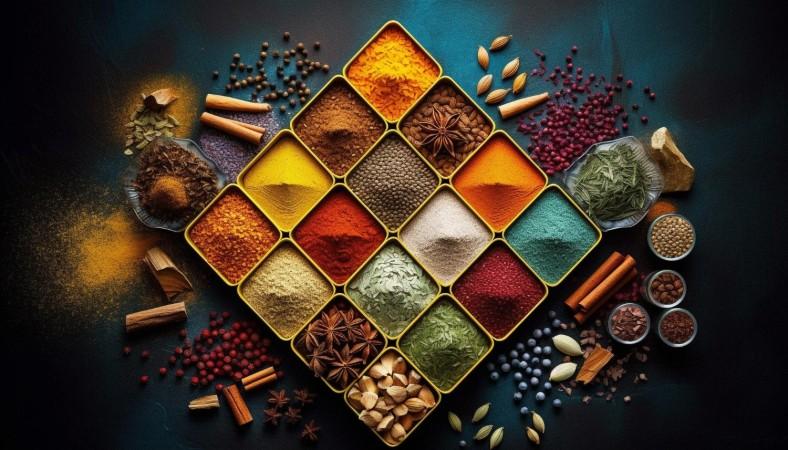
Culinary Uses of Indian Spices - © Zoff Foods
Health Benefits and Medicinal Uses
Beyond their culinary allure, Indian spices offer a treasure trove of health benefits and medicinal uses. In Indian culture, these spices aren't just ingredients; they're natural remedies passed down through generations, cherished for their holistic healing powers.
Turmeric
- Consists of curcumin, which has strong anti-inflammatory qualities.
- Used in Ayurvedic medicine to alleviate arthritis symptoms and aid digestion.
- Celebrated for its antioxidant capabilities, which promote general health and fitness.
Cinnamon
- Helps to balance blood sugar levels, making it useful for diabetic care.
- Lowering cholesterol and blood pressure helps to improve heart health.
- Often used to relieve menstrual cramps and improve circulation.
Cardamom
- Aids digestion and alleviates gastrointestinal disorders like indigestion and bloating.
- Contains essential oils that promote respiratory health and relieve respiratory conditions.
- Known for its detoxifying properties and ability to freshen breath.
Ginger
- Eases nausea and digestive discomfort, making it a staple remedy for motion sickness and morning sickness.
- Anti-inflammatory properties help reduce muscle pain and joint stiffness.
- Boosts immune function and helps fight off infections due to its antimicrobial properties.
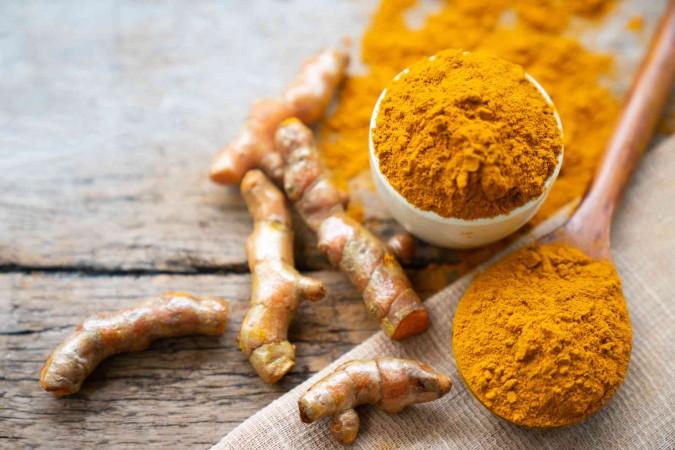
Tumeris Powder - © Health
Cultural Significance and Regional Variations
Spices in India are more than just culinary ingredients; they are profoundly ingrained in the country's cultural fabric, with each area having its own distinct spice repertory and culinary traditions.
North India
In the northern plains and foothills of the Himalayas, spices like cumin, coriander, and mustard seeds dominate the cuisine. These robust spices add depth and flavor to dishes like "rajma" (kidney bean curry) and "sarson ka saag" (mustard greens curry). The use of aromatic spices such as cloves, cardamom, and cinnamon also defines Mughlai cuisine, characterized by rich gravies and intricate spice blends like "garam masala."
South India
The southern states of Kerala, Karnataka, Tamil Nadu, and Andhra Pradesh are famous for their spicy and savory food. Here, spices like black pepper, curry leaves, tamarind, and coconut form the backbone of dishes such as "sambar" (a lentil-based stew), "rasam" (a tangy soup), and "avial" (mixed vegetable curry). Each state has its own unique spice blends, such as "chettinad masala" from Tamil Nadu, renowned for its fiery heat and complex flavors.
East India
Blessed with fertile plains and abundant rainfall, the eastern states of West Bengal, Odisha, Bihar, and Jharkhand boast a rich culinary heritage. Mustard oil, panch phoron (a blend of five spices including fenugreek, nigella seeds, cumin, black mustard, and fennel seeds), and fresh green chilies dominate the flavors here. Dishes like "machher jhol" (fish curry) from Bengal and "dalma" (a lentil and vegetable stew) from Odisha showcase the region's affinity for bold flavors and aromatic spices.
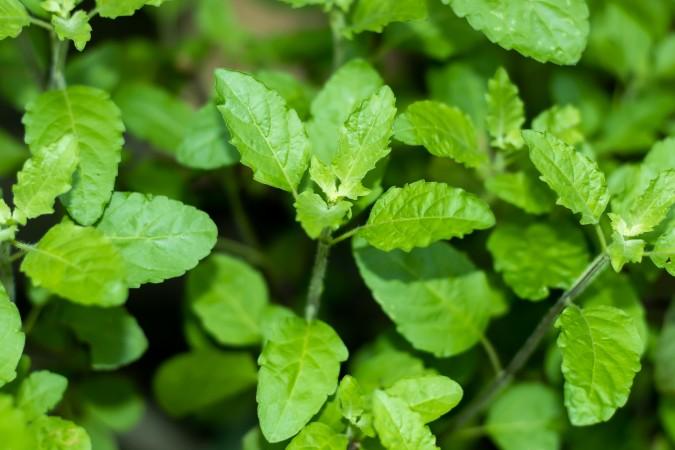
Holy Basil - © Abul Hossain Asif
West India
The western states of Gujarat, Maharashtra, Rajasthan, and Goa offer a diverse spice palette shaped by their geography and cultural influences. Gujarat is known for its sweet and savory "dhokla" (steamed cakes) flavored with mustard seeds and curry leaves. Maharashtra's "vada pav" (potato fritter sandwich) is spiced with "goda masala," a blend of roasted spices like coriander, sesame seeds, and coconut. Rajasthan's desert climate favors robust spices like dried red chilies, turmeric, and asafoetida, used in dishes such as "laal maas" (spicy red meat curry). Goa's cuisine, influenced by Portuguese colonization, features spices like cinnamon, cloves, and kokum in dishes like "vindaloo" and "fish curry."
Northeast India
The northeastern states of Assam, Meghalaya, Manipur, Mizoram, Nagaland, Arunachal Pradesh, and Tripura showcase a rich tapestry of tribal cultures and flavors. Here, spices like bhut jolokia (ghost pepper), bamboo shoot, and local herbs define traditional dishes such as "bamboo shoot curry" and "axone chutney." Each tribe and community in the northeast has its own unique spice traditions, reflecting the region's biodiversity and cultural diversity.
Coastal Regions
India's extensive coastline—from Gujarat in the west to West Bengal in the east and Kerala in the south—offers a bounty of seafood delicacies flavored with coastal spices. Here, spices like turmeric, fenugreek, coconut, and kokum (a souring agent) enhance dishes like "fish curry," "prawn masala," and "crab fry." Coastal communities also use spices for preserving seafood, creating pickles and marinades that celebrate the region's maritime bounty.
traditions of the region.
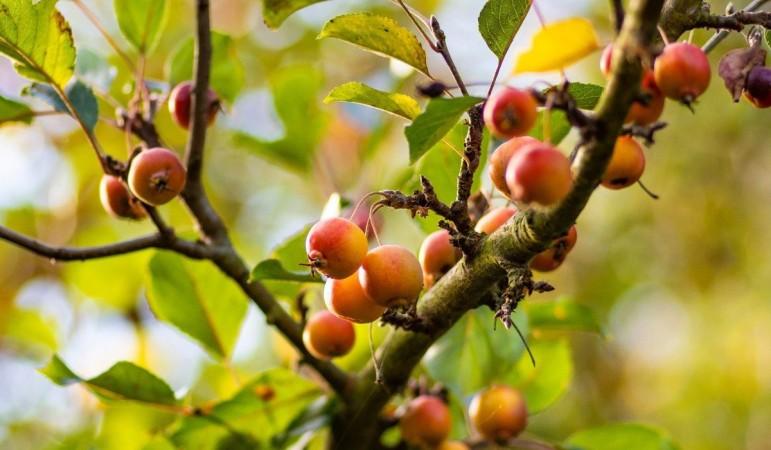
Kokum tree - © Boldsky
Seasonal and Festive Uses of Spices
In India, spices play a pivotal role in seasonal festivities, infusing traditional dishes with flavors that evoke the spirit of celebration. During Diwali, the Festival of Lights, homes are filled with the aroma of sweets like "gulab jamun" infused with cardamom and saffron. These spices symbolize prosperity and happiness, enriching the festive experience with their vibrant colors and aromatic allure.
Diwali (Festival of Lights)
Diwali, one of the most celebrated festivals in India, marks the victory of light over darkness. During this festival, homes are adorned with earthen lamps, and the aroma of festive sweets fills the air. Spices play a crucial role in Diwali treats:
- Cardamom: Used in sweets like "gulab jamun," "kheer" (rice pudding), and "laddoo," cardamom imparts a sweet, floral fragrance.
- Saffron: This precious spice is added to "ras malai" and "jalebi," giving these desserts a rich golden hue and unique flavor.
- Cloves and Cinnamon: These warming spices are used in "masala chai," a spiced tea that is a festive favorite.
Holi (Festival of Colors)
Holi, the bright celebration of colors, commemorates the entrance of spring and the triumph of goodness over evil. Spices add zest to Holi's festive foods:
- Saffron and Fennel Seeds: Key ingredients in "thandai," a cooling milk-based drink enriched with almonds, pistachios, and rose petals.
- Black Pepper and Ginger: These spices add a spicy kick to "kanji," a fermented drink made from black carrots and mustard seeds.
- Cumin and Coriander: Essential in savory snacks like "gujiya" (sweet dumplings) and "dahi bhalla" (fried lentil balls in yogurt).
Eid al-Fitr
Eid al-Fitr celebrates the completion of Ramadan, Muslims' holy month of fasting. Spices elevate the festive dishes prepared during this time:
- Cardamom and Nutmeg: Used in "sheer khurma," a sweet vermicelli pudding with dates and milk.
- Cinnamon and Bay Leaves: Integral to "biryani," a fragrant rice dish cooked with meat, saffron, and a blend of spices.
- Cloves and Star Anise: Enhance the flavors of "haleem," a slow-cooked stew made with meat, lentils, and wheat.
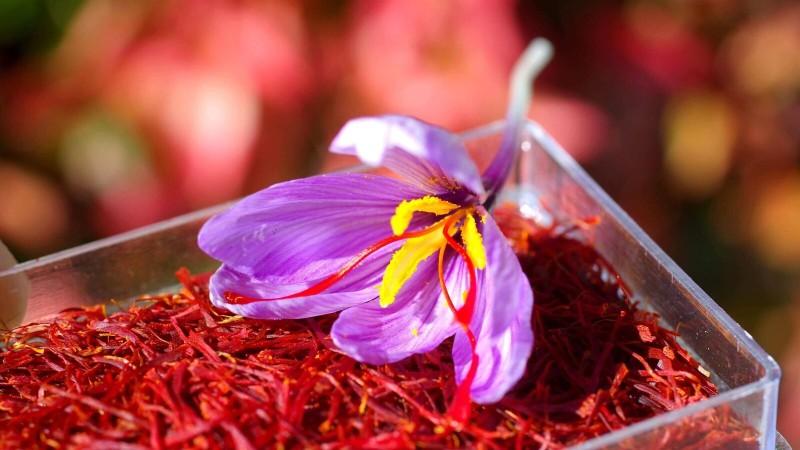
Saffron - © Mint
Navratri and Durga Puja
Navratri, a nine-night festival dedicated to the goddess Durga, culminates in Durga Puja. Spices feature prominently in the celebratory foods:
- Ginger and Cumin: Used in "sabudana khichdi," a meal prepared with tapioca pearls and potatoes that is popular during the fast.
- Mustard Seeds and Turmeric: Key ingredients in "bhog," a meal offered to the goddess and shared among devotees, including "khichuri" (rice and lentils) and "labra" (mixed vegetable curry).
- Bay Leaves and Cardamom: Flavorful spices in "payesh," a rice pudding made with jaggery and coconut milk.
Christmas in India
In India, Christmas is celebrated with a fusion of Indian and Western culinary traditions, with spices playing a starring role:
- Cinnamon, Nutmeg, and Cloves: Essential in "plum cake," a rich fruit cake soaked in rum or brandy.
- Star Anise and Cardamom: Infuse the festive "Christmas pudding" with their aromatic warmth.
- Ginger and Black Pepper: Used in "gingerbread cookies," adding a spicy and sweet touch to holiday treats.
Pongal and Makar Sankranti
These harvest festivals celebrated in South India (Pongal) and across the country (Makar Sankranti) feature dishes that showcase the bounty of the land:
- Black Pepper and Cumin: Vital in "ven pongal," a savory rice and lentil dish tempered with ghee and spices.
- Cardamom and Jaggery: Used in "sweet pongal" or "sakkarai pongal," a dessert made from rice, lentils, and jaggery.
- Sesame Seeds: Incorporated into "tilgul" (sesame seed and jaggery sweets), symbolizing warmth and community.
Ganesh Chaturthi
This festival celebrating Lord Ganesha's birthday involves elaborate feasts and offerings:
- Cardamom and Saffron: Key spices in "modak," a sweet dumpling believed to be Ganesha's favorite.
- Nutmeg and Cloves: Bring out the taste of "puran poli," a delicious flatbread stuffed with jaggery and chana dal.
- Cumin and Mustard Seeds: Used in "sundal," a savory dish made from chickpeas, coconut, and spices.
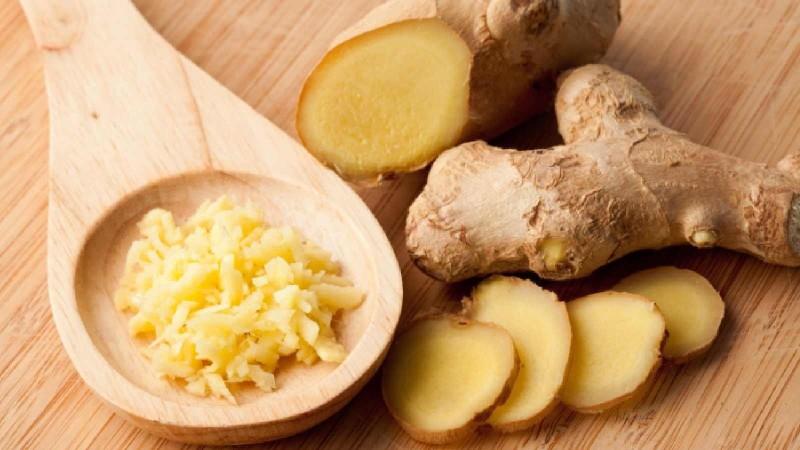
Ginger - © Healthshots
Conclusion
India's spice heritage is as diverse as it is ancient, weaving a tapestry of flavors that reflects its rich cultural tapestry. From the fiery warmth of chili peppers to the delicate aroma of saffron, each spice has a millennia-long history of tradition, health, and culinary talent. Beyond the scope of this text, learn about Indian spices in general. Discover local spice markets, try authentic recipes, and embark on a culinary journey that celebrates the richness of India's culinary heritage. Whether you're a seasoned chef or an adventurous food enthusiast, let the spices of India inspire your next culinary creation.
Articles for you

Experience Aboard The RV Indochine II - A Mekong Cruise With Tweet World Travel
The RV Indochine II is a luxury river cruise ship, offering an unforgettable journey through many attractions along the Mekong River. Built in 2017, this upscale vessel combines colonial elegance with modern conveniences to create a comfortable yet stylish environment for its crew and passengers. The ship’s intimate size makes it ideal for those seeking a more personal cruising experience while exploring Vietnam and Cambodia rich culture, scenery, and heritage. Whether you're gazing at the landscape from your private balcony or enjoying authentic local cuisine, RV Indochine II promises an exotic adventure like no other.

Witness Stilt Fishing In Sri Lanka: An Eco-Tourism Experience
Sri Lanka, renowned for its stunning beaches and rich cultural heritage, harbors a unique tradition that has captivated travelers for centuries: stilt fishing. This ancient practice, passed down through generations of coastal communities, blends artistry with necessity, offering a glimpse into a way of life intimately connected to the island's coastal rhythms. Stilt fishing in Sri Lanka isn't merely a means to catch fish; it's a cultural emblem, embodying the resilience and ingenuity of Sri Lanka's fishing communities.

Make Your Trip Stress-Free With The Tweet Trip App
Embark on your next adventure with confidence by downloading the Tweet Trip App, available for both iOS and Android. This essential travel companion allows you to view your detailed itinerary, stay connected with your tour guide and fellow travelers, receive real-time updates, and provide feedback effortlessly. With features like in-app messaging, emergency assistance, and location sharing, the Tweet Trip App ensures you travel smarter, stay connected, and enjoy a seamless, worry-free journey. Get started today and make the most of your travel experience with Tweet World Travel.

Pedal Through Paradise: Unveiling Cambodia's Hidden Gems on Two Wheels
The gentle whir of bicycle wheels mingles with the distant chants of monks as you glide past emerald rice paddies stretching to the horizon. This is Cambodia - a sensory explosion waiting to be experienced on two wheels. At Tweet Tours, we believe there's no better way to immerse yourself in the Kingdom of Wonder than by bicycle.
Cambodia isn't just a destination; it's a living, breathing tapestry of ancient wonders, natural beauty, and vibrant culture. Our carefully crafted cycling tours take you beyond the typical tourist haunts, offering a unique perspective on this captivating country. Ready to clip in and discover the magic of Cambodia? Let's ride!

Trekking in the Himalayas: A Journey Through Nepal's Majestic Peaks
The Himalayas rise from the earth like colossal guardians, their snow-capped peaks piercing the sky in a display of nature's raw power and beauty. Nepal, nestled at the heart of this mountain range, serves as the gateway to some of the most breathtaking trekking experiences on the planet. Here, the air is crisp and thin, filled with the promise of adventure and the whispers of ancient tales.
With Tweet Tours, as you set foot on these hallowed trails, you're not just a traveler - you're a modern-day explorer, following in the footsteps of legendary mountaineers and age-old traders. Each step takes you further into a world where nature reigns supreme and human resilience is tested against the backdrop of some of the world's highest peaks.
From the moment your boots touch the ground in Kathmandu, you'll feel the pull of the mountains. The bustling streets of the capital, with their sensory overload of sights, sounds, and smells, soon give way to serene mountain paths where the only soundtrack is the crunch of gravel underfoot and the distant tinkling of yak bells.

Exploring Mui Ne's Wonders: Unique Attractions & Local Dishes
Nestled along the southeastern coast of Vietnam, Mui Ne emerges as a captivating gem, blending natural wonders with cultural richness. Renowned for its stunning landscapes and unique attractions, Mui Ne beckons travelers seeking both relaxation and adventure in equal measure. Mui Ne's renowned beach dunes, bustling fishing towns, and excellent local food await exploration at every turn.
The allure of Mui Ne lies not only in its pristine beaches and crystal-clear waters but also in its diverse range of activities catering to every traveler's whims. Whether you're drawn to thrilling water sports like kitesurfing and windsurfing on its dynamic shores or seeking tranquility amidst the picturesque Fairy Stream, Mui Ne promises an unforgettable journey filled with discovery.
